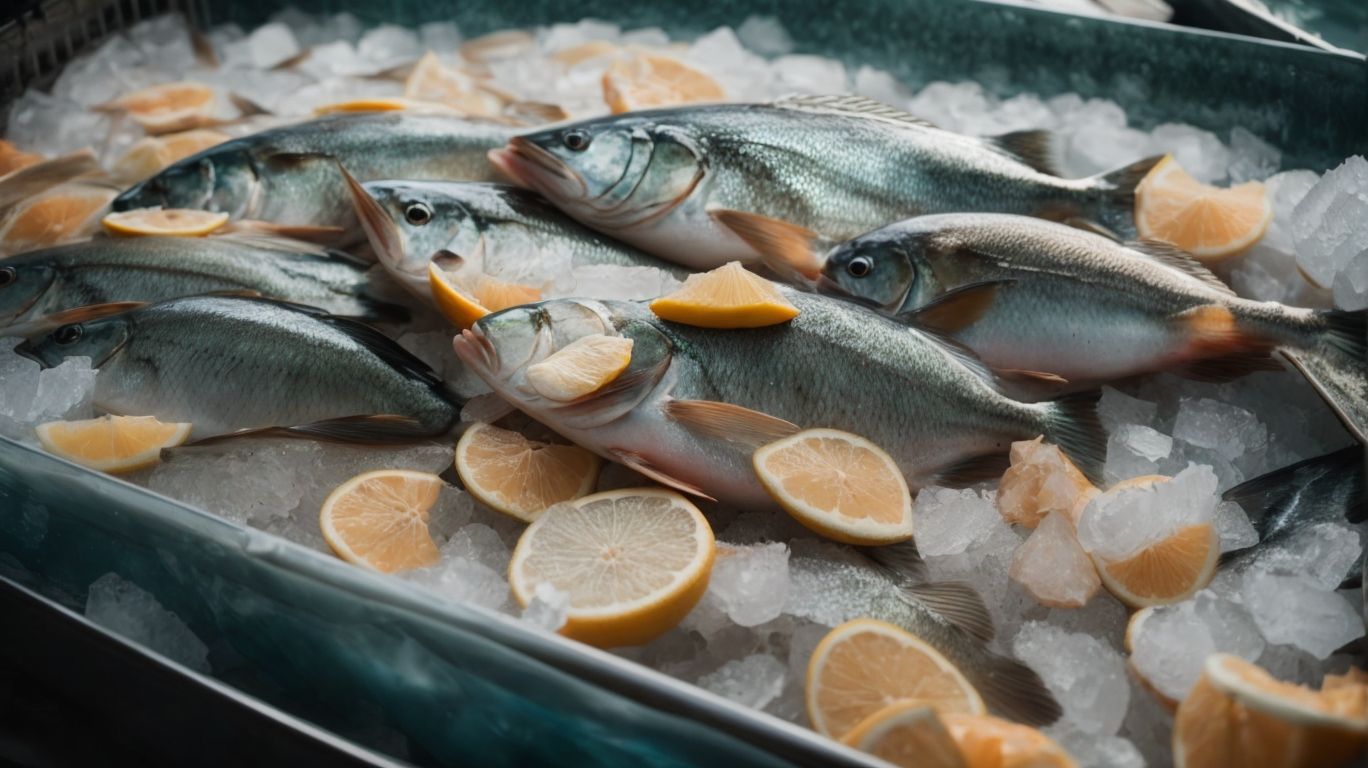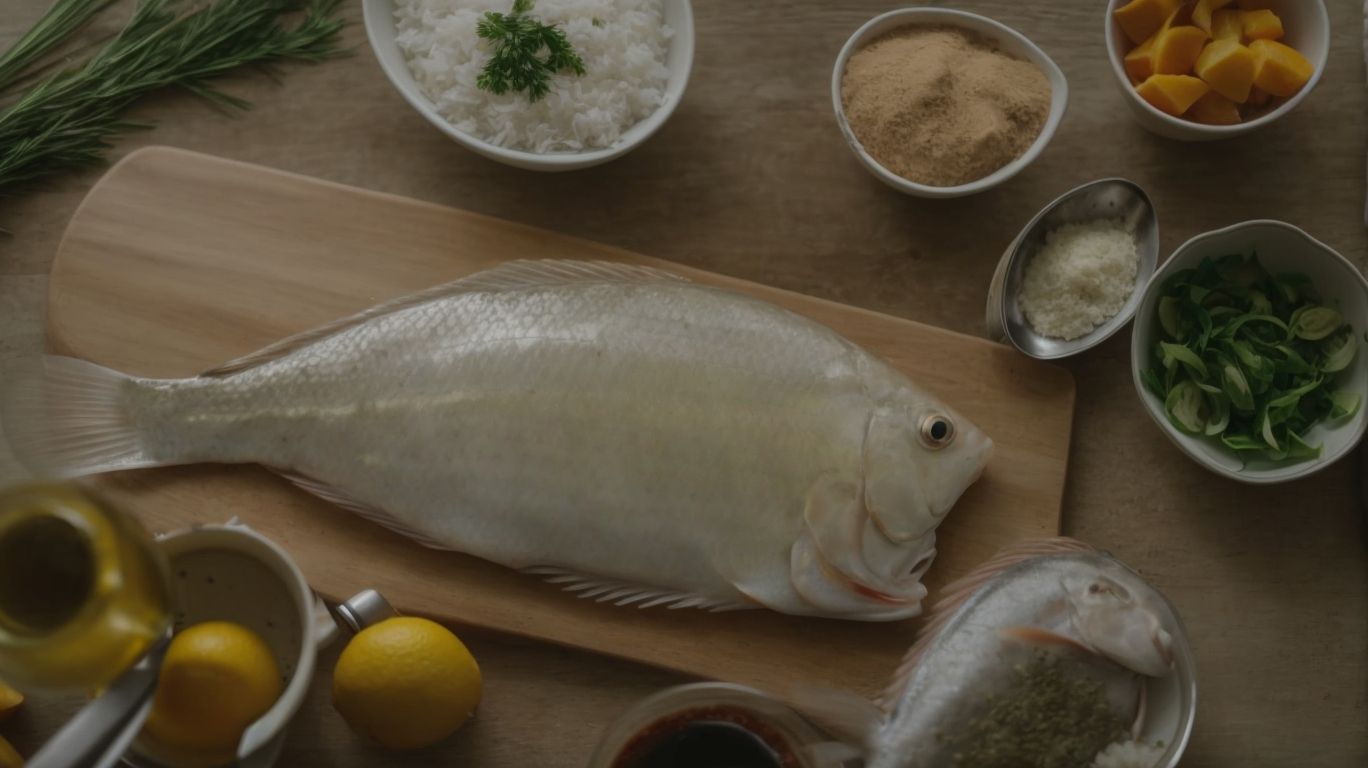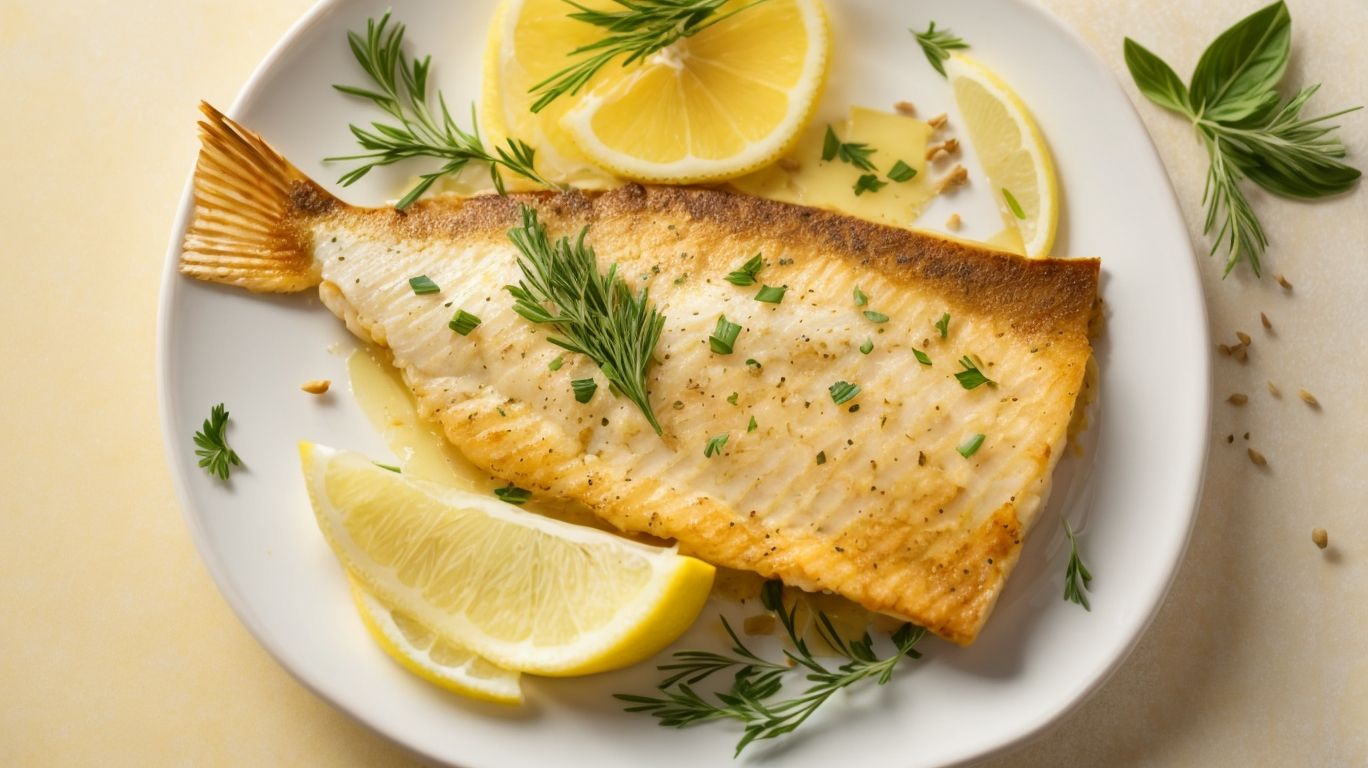How to Bake Flounder?
Are you looking to elevate your seafood game in the kitchen?
We will explore everything you need to know about baking flounder, from choosing the best flounder to preparing it for baking.
Discover the different types of flounder, how to ensure its freshness, and the essential ingredients and seasonings needed for a flavorful dish.
Stay tuned for some mouth-watering flounder baking recipes that will impress your friends and family at your next dinner gathering. Let’s get cooking!
Key Takeaways:
About Flounder
Flounder is a versatile fish known for its delicate flavor and tender texture, making it a favorite choice for many seafood enthusiasts.
Typically found along sandy ocean floors, flounder is distinguished by its flat, oval-shaped body and both eyes on one side. This unique anatomy allows it to blend seamlessly with its surroundings, making it a proficient ambush predator.
When prepared, flounder offers a sweet and mild taste, making it ideal for a variety of culinary preparations. Whether baked, grilled, or pan-seared, flounder adapts well to different cooking methods, absorbing flavors from herbs, spices, and sauces. Its flaky white flesh pairs beautifully with citrus, butter, and aromatic seasonings, creating a delightful seafood experience for any occasion.
What Is Flounder?
Flounder is a flatfish species that belongs to the Pleuronectidae family, characterized by its unique sideways swimming and camouflaging abilities.
Flounders are commonly found in shallow coastal waters and are known for their flat bodies and both eyes located on one side. They are bottom-dwellers, blending in with the sandy or muddy seabed to evade predators. Their diet consists of small fish, crustaceans, and mollusks.
These mild-tasting white fish are favored by many seafood enthusiasts for their delicate flavor and tender texture. Flounder is versatile in the kitchen, suitable for grilling, baking, or pan-searing. Its white flesh pairs well with lemon, herbs, and garlic, making it a popular choice for various seafood recipes.
What Are the Different Types of Flounder?
Various types of flounder exist, including the winter flounder, summer flounder, and European plaice, each offering distinct flavors and textures for culinary exploration.
Winter flounder, also known as blackback flounder, has a delicate, sweet flavor making it a favorite among seafood enthusiasts. On the other hand, the summer flounder, with its firm and meaty texture, is popular for grilling or pan-searing to enhance its natural taste.
European plaice, a common flatfish variety, boasts a mild flavor with a hint of sweetness, perfect for various cooking methods such as baking, grilling, or frying. When baked, a simple yet flavorful approach is to drizzle the flounder with lemon juice and sprinkle with fresh herbs before placing it in the oven.
How to Choose the Best Flounder for Baking?

Credits: Poormet.Com – Richard Perez
Selecting the best flounder for baking involves considering factors such as freshness, texture, and aroma to ensure a delightful culinary experience.
When choosing flounder at the market, opt for fish that has clear, shiny eyes and firm, bouncy flesh. Avoid any fish with a fishy odor, as this indicates it may not be as fresh. The texture of the flounder should be smooth and slightly translucent, ensuring a tender result after baking. Look for fillets with a clean, oceanic smell, a sign of its freshness and quality.
- For optimal flavor, seek flounder that has a delicate, sweet taste, complementing the garlic aioli you may pair it with. Making sure that the flounder not only looks fresh but smells and feels fresh will elevate your baked flounder dish to new heights.
What to Look for When Buying Flounder?
When purchasing flounder, look for firm flesh, clear eyes, and a fresh sea scent, indicating its quality and freshness for baking preparations.
For firmness, gently press the flesh to ensure it bounces back, indicating freshness. The eyes should be bright and clear, not cloudy or sunken, which are signs of deterioration. As you bring the fish closer, a clean ocean smell should greet your senses, a sign of the fish being truly fresh.
When preparing to bake, consider using cooking spray or olive oil to lightly coat the fillets for a flavorful and moist outcome. These baking supplies will enhance the flounder’s natural taste and keep it from sticking to the pan, making your dish a delightful culinary experience.
How to Ensure Freshness of Flounder?
To maintain the freshness of flounder, store it in the coldest part of the refrigerator, preferably on ice, and use it within one to two days to preserve its optimal flavor and texture for baking.
When storing flounder for future use, it is essential to ensure it stays well-chilled to prevent spoilage. Placing the flounder on a bed of ice or ice packs in the refrigerator is a great way to keep it at the ideal temperature. Remember that flounder is a delicate fish and can spoil quickly if not stored properly.
For an added flavor boost when baking flounder, consider using a coating made from a mixture of Parmesan crumbs and breadcrumbs. This combination not only adds a crispy texture to the dish but also enhances the overall taste profile of the flounder. Before coating the fish, ensure it is patted dry to help the coating adhere better during the baking process.
- Handle the flounder gently to avoid breaking the fillets, especially when applying the coating.
- Preheat the oven to the recommended temperature before placing the prepared flounder for baking.
- Monitor the baking time closely to prevent overcooking, as flounder cooks quickly due to its delicate nature.
What Are the Ingredients Needed for Baking Flounder?
Baking flounder requires minimal ingredients such as olive oil, lemon juice, and a blend of simple spices like sea salt, garlic powder, and smoked paprika for a flavorful and easy-to-prepare dish.
Adding seasoned bread crumbs to the mix can enhance the dish by providing a crispy texture that complements the tender flounder. Along with these ingredients, a dash of black pepper can add a subtle kick to the overall flavor profile.
To begin the baking process, preheat your oven to the recommended temperature for flounder, typically around 375°F.
Prepare a baking dish by lightly greasing it with olive oil to prevent sticking. Next, pat dry the flounder fillets with a paper towel to remove excess moisture, then place them in the baking dish.
In a small bowl, combine the olive oil, lemon juice, sea salt, garlic powder, smoked paprika, and seasoned bread crumbs. Mix well to create a flavorful marinade that will coat the flounder.
How to Prepare Flounder for Baking?

Credits: Poormet.Com – Eric White
Preparing flounder for baking involves filleting, seasoning, and coating the fish with a mixture of breadcrumbs, herbs, and a buttery mixture to enhance its taste and texture.
When filleting the flounder, ensure that you have a sharp knife and a clean work surface. Start by cutting along the backbone to remove the fillets, being careful to separate the flesh from the bones in a smooth motion.
For seasoning, consider using a blend of salt, pepper, garlic powder, and lemon zest to add a burst of flavor to the delicate fish.
Once seasoned, you can opt for a variety of coating methods. A popular choice is to dip the flounder in a mixture of flour, beaten eggs, and breadcrumbs for a crispy outer layer when baked.
How to Clean and Fillet Flounder?
Cleaning and filleting flounder involves removing scales, guts, and bones, ensuring the fish is ready for baking or cooking methods such as baking cod or using individually frozen fillets for convenience.
First, gather the necessary tools for cleaning and filleting flounder, which include a sharp fillet knife, cutting board, and a pair of kitchen shears.
- Start by rinsing the flounder under cold water and patting it dry with paper towels.
- Using your fillet knife, make a shallow incision behind the fish’s gills and run the blade down the belly to the tail, cutting through the skin.
Carefully remove the scales by scraping them off with the back of the knife or a fish scaler.
What Are Some Seasoning Options for Flounder?
Seasoning options for flounder range from simple blends of olive oil, sea salt, and lemon pepper to more complex flavors like Caribbean jerk or spicy Cajun seasoning, allowing for customized and full-flavored flounder dishes.
For a basic yet mouthwatering flavor profile, a combination of paprika, garlic powder, and onion powder can be generously sprinkled over flounder fillets before grilling or pan-searing. These common kitchen staples bring a rich aroma and familiar taste to the delicate fish without overpowering its natural flavors.
- For those looking to elevate their flounder experience, experimenting with smoked paprika, fresh herbs like thyme and parsley, or even a hint of truffle salt can add a luxurious twist to the dish. These adventurous seasonings can create a sensory explosion, transforming a simple fish meal into a gourmet delight.
How to Bake Flounder?
Baking flounder is a straightforward process that involves preheating the oven, placing the seasoned fish on a lined baking sheet, and cooking it in a comfortably hot oven for a crispy and succulent result, requiring minimal cleanup.
Once you have your flounder seasoned to perfection, it’s time to preheat your oven to 400°F (200°C) for that ideal balance of heat to cook the fish without drying it out. Ensuring your baking sheet is lined with parchment paper or aluminum foil not only aids in easy cleanup but also prevents the fish from sticking.
When placing the flounder on the baking sheet, make sure to leave some space between each fillet to ensure they cook evenly. Cooking time typically ranges between 10-15 minutes, depending on the thickness of the fish. To achieve that crispy finish, you may want to consider a quick broil for the last couple of minutes.
For optimal results, consider using a baking thermometer to ensure your flounder reaches an internal temperature of 145°F (63°C). This will guarantee the fish is cooked through while remaining moist and flavorful. And remember, a well-preheated oven is key to achieving consistent results every time.
What Temperature and Time is Best for Baking Flounder?
The ideal temperature and baking time for flounder is 375°F (190°C) for approximately 15-20 minutes, depending on the thickness of the fillets, ensuring a tender and flaky texture without overcooking the fish or the breading.
When preparing flounder with a delectable bread crumb coating, it’s crucial to preheat your oven to the specified temperature to achieve that perfect golden crust. Place the foil-wrapped fillets on a baking sheet, ensuring they are not overcrowded, allowing even heat distribution. Monitor the baking process closely, as flounder can easily overcook, resulting in a dry texture. For thicker fillets, adjust the baking time accordingly, ensuring the internal temperature reaches at least 145°F (63°C) for safe consumption.
What Are Some Tips for Baking Flounder?
To enhance the baking process of flounder, consider preheating the baking sheet, patting the fish dry before seasoning, and covering the fillets with foil to retain moisture and prevent excessive browning, resulting in perfectly baked flounder every time.
Preheating the baking sheet helps ensure that the flounder cooks evenly from the moment it touches the surface. Patting the fish dry is crucial as excess moisture can lead to steaming rather than proper baking. By wrapping the fillets in foil, you create a steamy environment that keeps the fish moist and tender. Remember to season the fish generously with herbs, lemon, salt, and pepper for a burst of flavor. Once baked, consider topping the flounder with a fresh salsa or a squeeze of lemon to elevate its taste.
What Are Some Delicious Flounder Baking Recipes?
Explore a range of delectable flounder baking recipes, such as Lemon and Herb Baked Flounder, Parmesan Crusted Baked Flounder, and Asian Style Baked Flounder, each offering unique flavors and textures for a delightful culinary experience.
These easy-to-follow recipes are perfect for both novice chefs and seasoned cooks. To create the Lemon and Herb Baked Flounder, you’ll need fresh flounder fillets, a juicy lemon, aromatic herbs like thyme and parsley, and a drizzle of olive oil. The Parmesan Crusted Baked Flounder features a crispy coating made with breadcrumbs, Parmesan cheese, and a hint of garlic powder. The Asian Style Baked Flounder brings a fusion of flavors with soy sauce, ginger, and a sprinkle of sesame seeds for a delicious twist.
Recipe 1: Lemon and Herb Baked Flounder
Lemon and Herb Baked Flounder combines zesty lemon juice, aromatic herbs, and a touch of garlic aioli to create a light and refreshing dish, seasoned with a sprinkle of sea salt for a burst of flavor in every bite.
If you’re looking to impress your guests with a dish that is both elegant and easy to prepare, this Lemon and Herb Baked Flounder recipe is a perfect choice. Here’s all you need to get started:
- 4 fresh flounder fillets
- 1/4 cup of lemon juice
- 2 tablespoons of olive oil
- 1 tablespoon of minced garlic
- A mixture of fresh herbs like parsley, dill, and thyme
- Sea salt and black pepper to taste
The preparation steps are simple and straightforward, ensuring that you achieve a perfectly baked flounder that’s bursting with flavor.
Recipe 2: Parmesan Crusted Baked Flounder
Parmesan Crusted Baked Flounder features a crispy coating of Parmesan crumbs and seasoned bread crumbs, creating a golden crust that locks in moisture, ensuring tender flounder with minimal cleanup, a perfect option for a quick and delicious meal.
Begin by preheating your oven to 400°F to ensure the ideal cooking temperature for the delicate flounder. For the coating mixture, combine Parmesan crumbs with a seasoned bread crumb mixture in a shallow bowl, incorporating flavors like garlic powder, paprika, and a dash of salt and pepper for that extra kick of taste and aroma.
Gently pat the flounder fillets dry and then dip them into a beaten egg mixture before generously coating them with the Parmesan and breadcrumb mixture. The key is to press the mixture firmly onto the fish to create a uniform and flavorful crust that will bake to perfection.
Recipe 3: Asian Style Baked Flounder
Asian Style Baked Flounder offers a fusion of bold flavors with Caribbean jerk seasoning, spicy Cajun seasoning, and a crunchy breadcrumb topping, creating a tantalizing dish that showcases a harmonious blend of sweet, spicy, and savory notes for a memorable dining experience.
Begin by marinating the flounder fillets in a vibrant mix of Caribbean jerk seasoning, allowing the fish to absorb the rich, aromatic flavors. The Cajun seasoning adds a kick of heat, complementing the sweetness of the flounder. The breadcrumb topping, a medley of panko and coconut flakes, brings a delightful crunch to every bite. As the flounder bakes, the seasonings infuse the fish with a depth of flavor that is both complex and intriguing.
Frequently Asked Questions
What is the best way to bake flounder?
The best way to bake flounder is to preheat your oven to 375 degrees Fahrenheit, place the flounder in a baking dish, and bake for 12-15 minutes. You can also add your favorite seasonings and toppings to enhance the flavor.
Can I use any type of flounder for baking?
Yes, you can use any type of flounder for baking. However, some types may have a stronger flavor than others. It’s best to experiment and find the one that you enjoy the most.
How do I know when the flounder is done baking?
The flounder is done baking when it reaches an internal temperature of 145 degrees Fahrenheit and flakes easily with a fork. This usually takes about 12-15 minutes, depending on the thickness of the flounder fillets.
What are some good seasonings and toppings to use when baking flounder?
Some good seasonings and toppings for baked flounder include lemon, garlic, herbs such as thyme or parsley, and butter. You can also add breadcrumbs or Parmesan cheese for a crispy topping.
Can I bake frozen flounder?
Yes, you can bake frozen flounder. However, it may take longer to cook and may not have the same texture as fresh flounder. It’s best to thaw the flounder before baking for the best results.
What side dishes go well with baked flounder?
Baked flounder goes well with a variety of side dishes, such as roasted vegetables, rice, quinoa, or a fresh salad. You can also pair it with a creamy sauce or a citrus-based sauce for added flavor.

